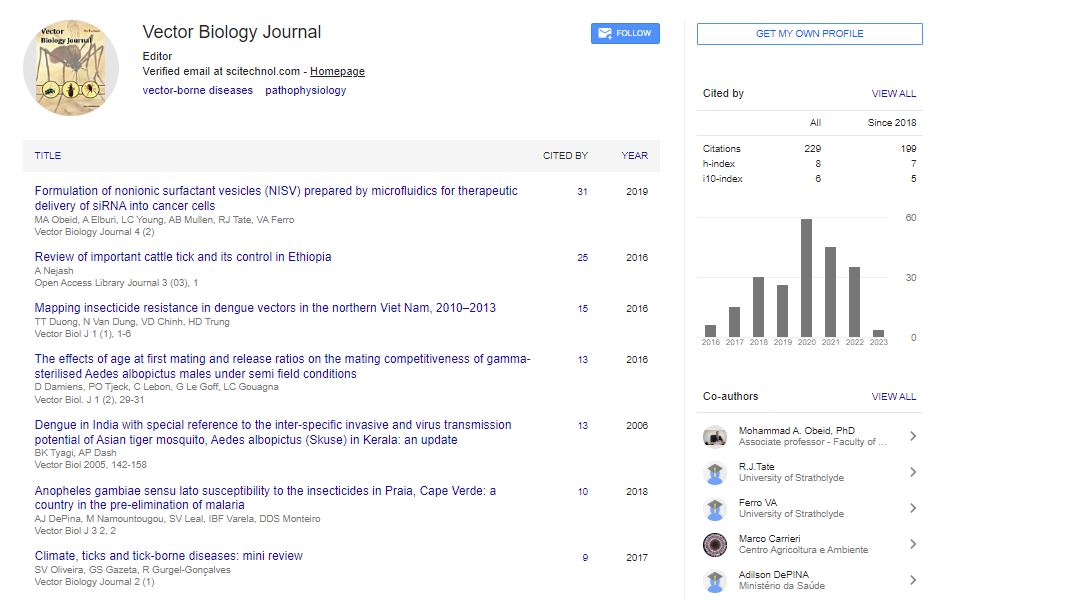Perspective, Vector Biol J Vol: 8 Issue: 3
Examining Variables Affecting Dispersal and Disease Transmission in Ticks
Hoel Diletta*
1Department of Biology, Vytautas Magnus University, Kaunas, Lithuania
*Corresponding Author: Hoel Diletta,
Department of Biology, Vytautas Magnus
University, Kaunas, Lithuania
E-mail: Dilettaoel09@gmail.com
Received date: 28 August, 2023, Manuscript No. VBJ-23-117764;
Editor assigned date: 30 August, 2023, PreQC No. VBJ-23-117764 (PQ);
Reviewed date: 13 September, 2023, QC No. VBJ-23-117764;
Revised date: 21 September, 2023, Manuscript No. VBJ-23-117764 (R);
Published date: 29 September, 2023, DOI: 10.4172/2473-4810.1000275
Citation: Diletta H (2023) Examining Variables Affecting Dispersal and Disease Transmission in Ticks. Vector Biol J 8:3.
Description
Ticks are blood-feeding ectoparasites that play a significant role in disease transmission and pose a substantial threat to both human and animal health. This study explores the distribution and ecology of ticks in sympatric and allopatric zones in eastern areas, shedding light on the factors influencing tick populations and the potential consequences for disease dynamics. Understanding tick distributions in these regions is essential for effective tick-borne disease management and prevention.
Ticks are arachnid ectoparasites that are widely distributed across the globe, and they are known vectors for various pathogens, including bacteria, viruses, and protozoa. In eastern areas, these ectoparasites exhibit distinct patterns of distribution, with sympatric and allopatric zones being of particular interest. Sympatric zones refer to areas where multiple tick species overlap, while allopatric zones represent regions where a single tick species predominates. This study aims to elucidate the factors contributing to tick distribution in these zones and their implications for tick-borne diseases.
Factors influencing tick distribution
Several factors contribute to tick distribution in sympatric and allopatric zones. These include:
Host availability: Ticks are highly host-specific, and the availability of suitable hosts greatly influences their distribution. Sympatric zones may provide a broader range of host species, resulting in diverse tick communities. In contrast, allopatric zones often have a dominant host species, leading to a higher prevalence of a single tick species.
Climate and habitat: Temperature, humidity, and vegetation play important roles in tick distribution. Sympatric zones often have more diverse microclimates and habitats, allowing multiple tick species to thrive. Allopatric zones may be characterized by a more uniform environment, favoring a single tick species.
Competition and niche partitioning: In sympatric zones, tick species must compete for resources, which can lead to niche partitioning, where each species occupies a distinct ecological niche. In allopatric zones, the dominant tick species has less competition, potentially leading to increased population sizes.
Tick-borne diseases in sympatric and allopatric zones
The distribution of tick species in sympatric and allopatric zones has direct implications for tick-borne diseases. Sympatric zones may have a higher diversity of tick species, potentially leading to a greater diversity of pathogens. This can increase the risk of multiple pathogen transmission to hosts, making disease management more complex.
In contrast, allopatric zones may be dominated by a single tick species, which can serve as a more efficient vector for specific pathogens. This can lead to the amplification and increased transmission of particular diseases. Understanding the distribution of ticks in these zones is important for targeted disease surveillance and control measures.
Implications for disease management and prevention
Effective tick-borne disease management and prevention strategies should consider the distribution of ticks in sympatric and allopatric zones. This may include:
Targeted surveillance: In sympatric zones, surveillance efforts should focus on monitoring a broader range of tick species and the pathogens they carry. In allopatric zones, emphasis should be placed on the dominant tick species.
Host control: Efforts to reduce host populations, such as deer or rodents, can help mitigate tick populations in sympatric zones, where diverse host species are common. In allopatric zones, control measures should focus on the primary host.
Pathogen research: Understanding the pathogens associated with different tick species in sympatric and allopatric zones is essential for developing effective treatments and vaccines.
Conclusion
Ticks play a pivotal role in the transmission of various diseases in eastern areas, with their distribution influenced by a complex interplay of factors in sympatric and allopatric zones. Recognizing these patterns and understanding their implications for disease dynamics is important for the effective management and prevention of tick-borne diseases. Future analysis should continue to explore the ecological and epidemiological factors shaping tick populations in these regions, ultimately contributing to improved public and animal health.
 Spanish
Spanish  Chinese
Chinese  Russian
Russian  German
German  French
French  Japanese
Japanese  Portuguese
Portuguese  Hindi
Hindi 